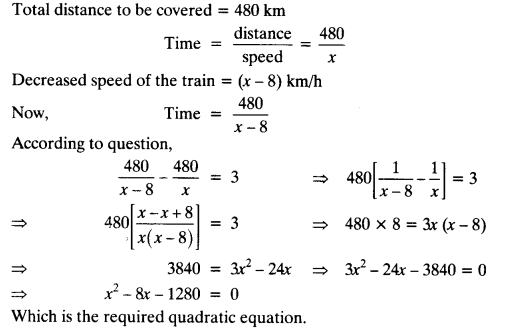Chapter 4 Quadratic Equations Ex 4.1
Question 1.
Check whether the following are quadratic equations:
(i) (x+ 1)2=2(x-3)
(ii) x – 2x = (- 2) (3-x)
(iii) (x – 2) (x + 1) = (x – 1) (x + 3)
(iv) (x – 3) (2x + 1) = x (x + 5)
(v) (2x – 1) (x – 3) = (x + 5) (x – 1)
(vi) x2 + 3x + 1 = (x – 2)2
(vii) (x + 2)3 = 2x(x2 – 1)
(viii) x3 -4x2 -x + 1 = (x-2)3
Solution:
(i) (x+ 1)2=2(x-3)
⇒ x2 + 2x +1 = 2x – 6
⇒ x2 + 2x – 2x+1 + 6 = 0
⇒ x2 + 7 = 0
⇒ x2 + 0x + 1 = 0
Which is of the form
ax2 + bx + c = 0
Hence, the given equation is a quadratic equation.
(ii) x2 – 2x = (- 2) (3 -x)
⇒ x2 -2x = -6 + 2x
⇒ x2 -4x + 6 = 0
Which is of the form
ax2 + bx + c = 0
Hence, the given equation is a quadratic equation.
(iii) (x – 2) (x + 1) = (x – 1) (x + 3)
⇒ x2 + x-2x-2 = x2 + 3x-x -3
⇒ x2 + x – 2x – 2 = x2 – 3x + x + 3 = 0
⇒ – 3x + 1 = 0 ⇒ 3x – 1 = 0
Since degree of equation is 1, hence, given equation is not a quadratic equation.
(iv) (x-3) (2x+ 1) = x (x + 5)
⇒ 2x2 + x – 6x – 3 = x2 + 5x
2x2 + x – 6x – 3-x2 – 5x = 0
⇒ x2 – 10x -3 = 0
Which is of the form
ax2 + bx + c 0
Hence, the given equation is a quadratic equation.
(v) (2x-1)(x-3) = (x + 5)(x-1)
⇒ 2x2 – 6x-x + 3 = x2 -x + 5x – 5
2x2 – 6x-x + 3 = x2 + x – 5x + 5 = 0
⇒ x2 – 11x + 8 = 0
Which is of the form
ax2 + bx + c = 0
Hence, the given equation is a quadratic equation.
(vi) x2 + 3x + 1 = (x-2)2
⇒ x2 + 3x + 1 = x2 + 4 – 4x
⇒ x2 + 3x + 1 = x2– 4 + 4c = 0
⇒ 7x – 3 = 0
Since degree of equation is 1, hence, the given equation is not a quadratic equation,
(vii) (x + 2)3 = 2x (x2 – 1)
⇒ x3 + 8 + 3.x.2 (x + 2) = 2x3 – 2x
⇒ x3 + 8 + 6x2 + 12x = 2x3 – 2x
⇒ x3 – 6x2 – 14x – 8 = 0
Which is not of the form
ax2 + bx + c = 0
Hence, the given equation is not a quadratic equation.
(viii) x3 – 4x2 – x+1 = (x-2)3
⇒ x3 – 4x2 – x + 1 = x3-8 + 3x(-2)(x – 2)
⇒ x3 – 4x2 -x + 1 = x3 – 6x2 + 12x – 8
⇒ 2x2 – 13x + 9 = 0
Which is of the form
ax2 + bx + c = 0
Hence, the given equation is a quadratic equation.
Question 2.
Represent the following situations in the form of quadratic equations:
(i) The area of a rectangular plot is 528 m2. The length of the plot (in metres) is one more than twice its breadth. We need to find the length and breadth of the plot.
(ii) The product of two consecutive positive integers is 306. We need to find the integers.
(iii) Rohan’s mother is 26 years older than him. The product of their ages (in years) 3 years from now will be 360. We would like to find Rohan’s present age.
(iv) A train travels a distance of 480 km at a uniform speed. If the speed had been 8 km/h less, then it would have taken 3 hours more to cover the same distance. We need to find the speed of the train.
Solution:
(i) Let breadth of the rectangular plot = x m
Then, length of the plot = (2x + 1)m
Area of a rectangular plot = l x b ,
⇒ 528 (2x + 1)x
⇒ 528 = 2x2 +x
⇒ 2x2 + x – 528 = 0
Which is the required quadratic equation.
(ii) Let the two consecutive integers be x and x + 1
Then, x(x+l) = 306
⇒ x2 +x-306 = 0
Which is the required quadratic equation.
(iii) Let the present age of Rohan = x years
Rohan’s mother’s present age = (x + 26) years
After 3 years, Rohan’s age = (x + 3) years
After 3 years, Rohan’s mother’s age = (x + 26 + 3) years
According to question,
(x + 3) (x + 29) = 360
⇒ x2 + 29x + 3x + 87 – 360 = 0
⇒ x2 + 32x – 273 = 0
Which is the required quadratic equation.
(iv) Let speed of the train = x km/h
